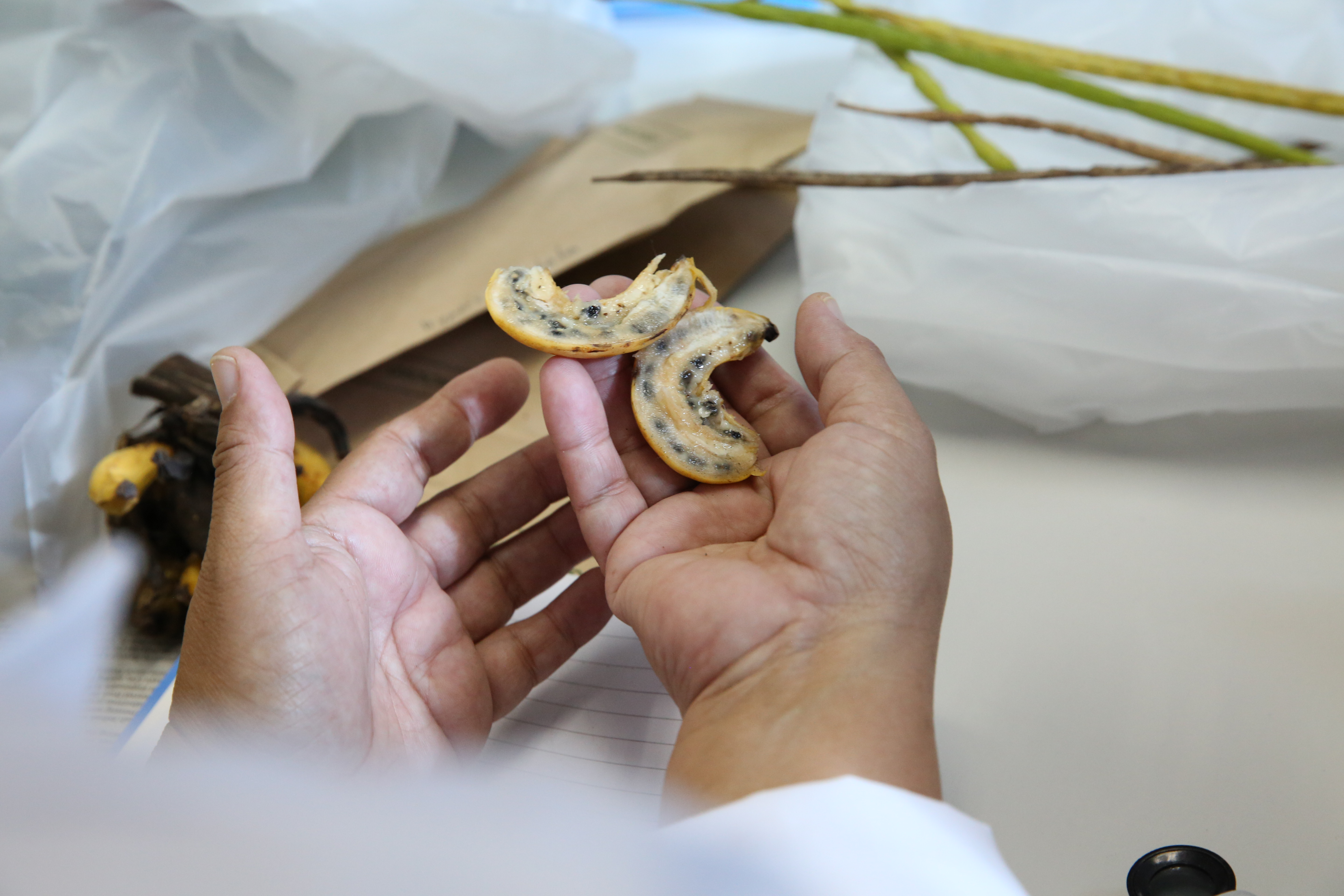Banana
Musa spp.
About 150 million tonnes of bananas are harvested annually throughout the tropics, but only 15% or so (mainly dessert types) is traded internationally. Most bananas are grown for home consumption or for sale in domestic or regional markets. The cooking types are especially important for food security. East Africa has the highest consumption rates, with up to 1 kg a day per person.
Because bananas are multiplied vegetatively, all the individuals in a plantation may be genetically identical clones. This makes banana plantations highly susceptible to outbreaks of pests and diseases. The threat to internationally-traded varieties from new races of pathogens has created worldwide alarm and a drive to develop resistant varieties. Another target of banana breeding is to create varieties that offer better nutrition. This is especially important where bananas are a staple crop, or used to wean children onto solid food. Efforts are focused on increasing levels of vitamin A precursors.
A naming system for banana groups varieties according to the contribution of their wild ancestors, designated by the letter A for M. acuminata and B for M. balbisiana. For example, the AA genome group comprises diploid varieties that have two acuminata genomes, while the AAB genome group is for triploid varieties that have one balbisiana genome and two acuminata genomes.
The main subgroups of dessert bananas are Cavendish (AAA), Gros Michel (AAA), Mysore (AAB), Pome (AAB), Silk (AAB), Sucrier (AA) and Ney Poovan (AB).
The main subgroups of cooking bananas are East African Highland Bananas (AAA), Plantain (AAB), Maoli-Popoulu (AAB), Bluggoe (ABB), Saba (ABB) and Pisang Awak (ABB).
Wild Relatives
More than 50 species of wild banana are believed to exist, but two species, Musa acuminata and Musa balbisiana, are known for their role in the domestication of most types of edible banana. A distinct group of cultivars, Fe’i bananas, developed independently in the Pacific region. Overall, there are believed to be approximately 1000 varieties of cultivated bananas.
Wild bananas produce inedible fruits that are full of seeds and are diploid; that is, they have two complete sets of chromosomes. Most domesticated bananas are triploid, with three sets of chromosomes. With a few exceptions, triploid varieties are more vigorous and productive and have replaced diploid varieties, which are now rare.
Collecting
Collecting Projects
Banana originated in Southeast Asia and the Pacific region and is believed to have first been domesticated more than 7000 BP. East and Central Africa are secondary centers of diversity.
Collections
There are at least 60 major banana collections worldwide. A survey completed in 2015 reported that 56 field collections of banana together hold more than 9,000 accessions. About 31 of the institutes surveyed also hold in vitro collections, which in total contain slightly more than 4,500 accessions. The The International Musa Germplasm Transit Centre managed by Bioversity International holds 1,500 accessions in vitro and 950 accessions under cryopreservation.
Other banana collections with rich banana diversity or that provide relevant research, expertise, services or capacity building include: BPI, Philippines; CARBAP, Cameroon; CIRAD, France; FHIA, Honduras; DPI&F, Australia; EMBRAPA, Brazil; IEB, Czech Republic; IITA, Nigeria and Uganda; NARO, Uganda; NRCB, India; ARC, South Africa; SPC, Fiji; USDA-TARS, Puerto Rico.
Genesys lists 2,537 accessions. About 11% of the accessions listed in Genesys are wild relatives. While the fruit of most of these is inedible, they are very important in efforts to breed new varieties.
Bioversity also maintains ProMusa, a portal with the latest news, research results and general knowledge about bananas.
A global strategy for the conservation and use of Musa genetic resources was prepared in 2007. These strategies identify actions to better understand the diversity of Musa species and thus identify potential uses in breeding, and opportunities to improve the management of existing collections.
Conservation methods
Most cultivated bananas do not produce seeds, so accessions have to be preserved as tissue cultures in vitro and in field genebanks. Edible bananas are usually seedless and options for long-term conservation are therefore limited by the vegetative nature of the plant’s reproductive system. This germplasm can be conserved as plants in fields or screenhouses (field banks), as tissue culture in slow-growth conditions and in cryopreservation.
Germplasm of wild bananas, including the ancestors of our edible bananas, Musa acuminate and Musa balbisiana, can be conserved as seeds. Genes can also be maintained in the form of DNA (as DNA or as lyophilized leaves) and as cryopreserved pollen.

